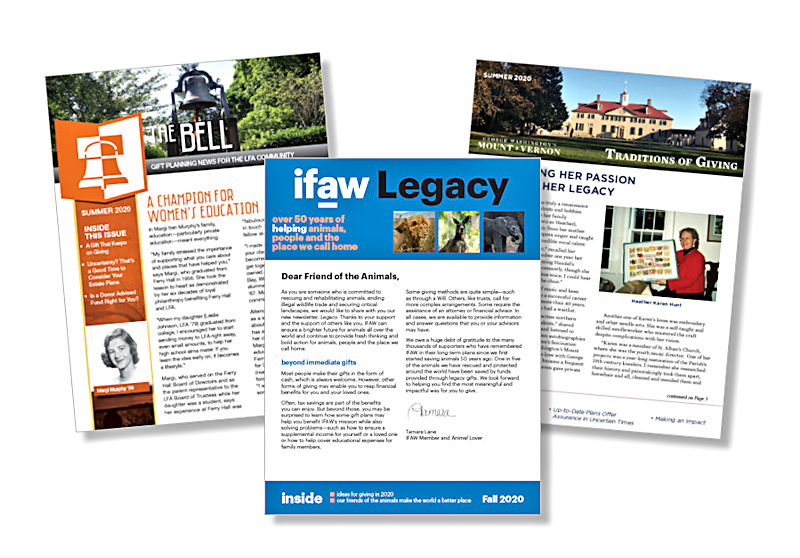
A planned giving newsletter is one of the most effective ways to reach donors who can and will make planned gifts in the future. The first step is to identify who your donors are in terms of age, gender, marital status and wealth. It is critically important to identify your best prospects so you are getting the most out of your planned giving newsletter and targeting those who are at the stage in life where they are thinking about their estate plans. And, by the way, Sharpe can help with that through our Donor Data Enhancement Service and analyzing your data with Artificial Intelligence.
Depending on the demographics of your donor base and budget dollars, you may want to avoid sending your newsletter to a large group. Analyze your mailing list and identify those who have given more than 10 times in the last five to 10 years. This will narrow your list down to your most loyal donors, making your newsletter that much more effective. Every constituency is different. Doing a targeted mailing to a core audience, as opposed to a small segment mentioning planned giving in a general publication, allows your message to better resonate with your audience. Sending a planned giving mailing three to four times a year will keep your organization at the front of a donor’s mind.
A newsletter that solely focuses on planned giving will offer the reader a balanced blend of gift planning educational topics, information about your mission, donor stories and useful estate, tax and financial planning strategies that will spark interest. Make sure you avoid technical jargon. Featured gift options should be clearly explained, concise and easily understandable. Use examples of gifts in case studies as well as donor testimonials. Stories about your planned giving donors are relatable and a great way to draw the reader into your newsletter.
Including a response device with the newsletter will improve responses significantly. A reply card offers your donors the opportunity to request more information and allows them to indicate whether they are considering including or have included your organization in their estate plans. You can also choose to include a short survey to learn more about them on the reverse side. This will provide qualified leads for personal follow-up.
Using follow-up pieces such as informational booklets can spark curiosity in donors, allowing you to follow up with more information on a particular gift option. Response rates increase when you offer information on recent tax law changes or estate and financial planning materials that are useful to the reader. Engaging the reader with “rate your estate plan” exercises or other self-testing articles also improves response.
Studies have shown that 73% of Americans still prefer direct mail over digital because they can review the materials on their own time. When creating a planned giving newsletter, it is important to keep the donor in mind by sending out engaging, impactful and beneficial information that will build a long-term relationship between your organization and the donor’s lasting legacy.
By Jana Lawyer, Sharpe Group Senior Consultant
For more information about gift planning newsletters, click here.

Sharpe Group will continue to post helpful information for you here on our blog and on our social media sites. If this blog was shared with you and you wish to sign up, you can do so at www.SHARPEnet.com/blog.
We can be found on Facebook, Twitter and LinkedIn @sharpegroup.
We welcome questions you’d like us to address. Email us at info@SHARPEnet.com and we’ll share your question and our thoughts in this blog and on social media.

